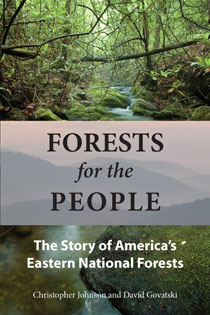"As in the national forests, there is something for anyone to learn about in Forests for the People."
Ecology
"The book is well organized and well written in a clear, jargon-free style....With its clear, straightforward style, Forests for the People is a valuable information source for researchers, students, and concerned members of the public."
Native Plants Journal
"The book's overall structure, split between historical narrative and case studies, makes it ideal for classroom use ... In documenting the path taken to create and manage the national forests of the eastern United States—a very different path from that of their western counterparts—the book illuminates crucial issues facing America's national forests, East and West"
Forest History Today
"gripping detail... fascinating historic context...Our forests need many heroes. Johnson and Govatski provide the background, issues and motivation for the people to join a historical procession of champions—champions who have always been essential to protecting forests."
Wisconsin Sierra Club's Green Review
"In short, this book provides an academically rigorous yet thoroughly absorbing account of the national forests of the eastern USA, from formation impetuses through to the breadth of present-day management challenges and solutions."
Beneath the Treeline
"A nice blend of the history of our national forests and the current issues challenging them."
Wildlife Activist
"The book is well organized and well written in a clear, jargon-free style."
Native Plants Journal
"In sum, this book is a valuable resource for those who seek to better understand the evolution of forest policy, for environmentalists interested in developing effective strategies for collaborating with forest managers, and for historians seeking a concise overview of the development of the eastern forests. It is also likely to send readers into their gear closets, inspired to pursue new adventures in formerly unfamiliar parts of the eastern national forests."
Environmental History
"The first part of the volume provides the most detailed coverage of the establishment of eastern national forests that this reviewer has ever seen......a resource for students of both US forest history and forest policy."
Choice
"Overall, the book nicely traces the challenges faced and perseverance required to move the political will of a country towards a major environmental legacy. [Forests for the People] provides hope that, with perseverance and knowledge gained by scientists across the globe, we will move down the path of sustainability so desperately needed."
Landscape Ecology
"The Weeks Act of 1911 is one of the twentieth century's most significant environmental laws. Few recall its powerful impact on once-cutover eastern forests, though their flourishing condition today is compelling evidence of its significance. Forests for the People probes this remarkable recovery and offers an engaging account of the Weeks Act's complex legacy; it rightly warns that we are not yet out of the woods."
Char Miller, W. M. Keck Professor of Environmental Analysis, Pomona College
"Forests for the People both deepened and broadened my understanding of and appreciation for the eastern national forests and the struggle to create and manage them. By providing the first comprehensive history of the Weeks Act and then, through case studies, carefully examining the challenges of implementing the law over the last century, the authors have helped frame the discussion for managing all our national forests in its second century."
James G. Lewis, Forest History Society

